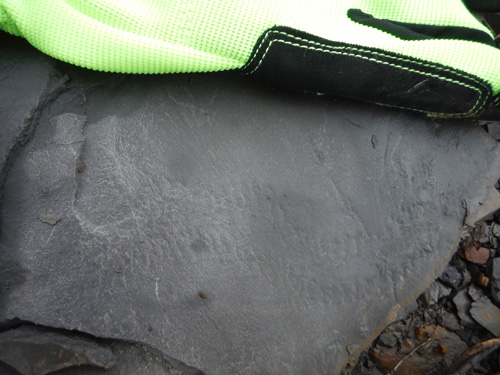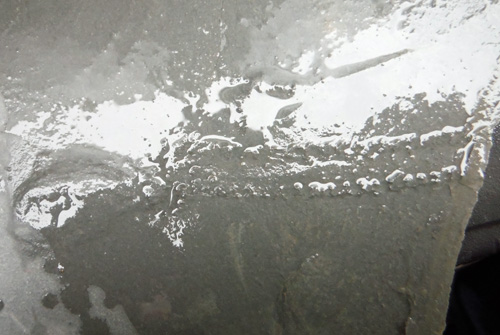GMS Field Trip
If you have any questions about field trips send email toGMS Field Trip
Pennsylvanian Tracks and Plants in Alabama
Saturday, February 25, 2018
The February field trip was delayed from the 10th to the 25th because of rain, and we still had to contend with some rain, but fortunately it worked to our advantage. The site we visited consists mostly of shale, so the area was not muddy. The trace fossils there can be difficult to see as they are impressions in the shale and need to be viewed from an angle that allows a certain amount of shadowing to make them visible. But water helps too, and there was just enough rain to keep the shale wet so the traces were easier to see.
The fossils here are found in a Carboniferous (Pennsylvanian) layer of shale and sandstone and are around 314 million years old. While plant material in other parts of this area were converted to coal, a lot of plant material at this site was preserved, so field trip attendees found a great deal of ferns and other leaves. Daniel Miller found a seed pod. We even found some stigmaria, in this case the root scars of Lepidodendron, a large, primitive, extinct, tree-like plant, plus a sizeable portion of a Lepidodendron “trunk”. Bob Dolezal found an incredible specimen of some sort of reed that is so well-preserved it looks like it fell only a few days ago. My favorite plant find is a rock with starburst shaped specimens that appear to be Annularia, i.e. the leaves of Calamites, another extinct, tree-like plant. Calamites is related to modern horsetail plants.
This site provides an incredible opportunity to collect amphibian and arthropod tracks as well as other trace fossils. New member, Sim, found some spectacular little footprints, probably Cincosaurus cobbi, the tracks of a small amphibian. She also found some tracks that look like a tiny bulldozer lumbered over the ancient mud, but they are most likely from an arthropod. Henry Frantz found some horseshoe crab tracks, too. I saw a set of tracks that appear to end in a resting trace as well. I was very fortunate to flip some shale and find a trace of fish fins scraping the sediment as a fish swam by.
Despite the threat of rain, the trip was productive and fun. Many thanks to the Alabama Paleontological Society for providing access to the site as well as expert opinions on what we found. Also, thank you to Daniel Miller for leading the trip since Charles was not able to be there. And thank you to all of the people who attended the trip and made it a most enjoyable day!
Lori Carter
On behalf of Charles Carter, GMS Field Trip Chair
e-mail:
Photos by Lori Carter


New member Sim found these Cincosaurus cobbi, the tracks of a small amphibian
Photos by Lori Carter


Sim also found these unidentified tracks (crudely marked for contrast in the 2nd image)
Photo by Lori Carter

Fish fin swish marks
Photo by Lori Carter

Small feather-like leaf (upper left) and long frilly leaf (center)
Photo by Lori Carter

Wonderful specimen with leaves on a stem
Photo by Lori Carter

Bob Dolezal found this well-preserved reed
Photo by Lori Carter

Stigmaria i.e. root scars, probably Lepidodendron, an extinct tree-like plant
Photo by Lori Carter

Larger view of the stigmaria with car keys for scale
Photo by Lori Carter

Lepidodendron "trunk"
Photo by Lori Carter

Annularia, i.e. the leaves of Calamites, another extinct, tree-like plant
Photos by Lori Carter


Unidentified positive and negative tracks with possible resting trace
Photos by Randy Gentry


Randy gentry found this unidentified specimen (2 views)
Click below for field trip policies

Copyright © Georgia Mineral Society, Inc.
